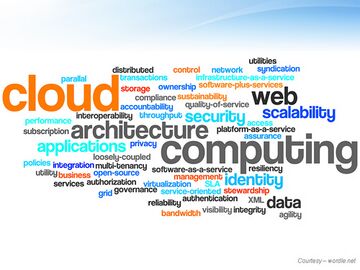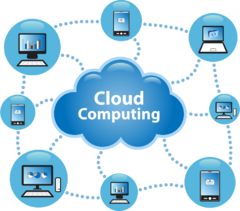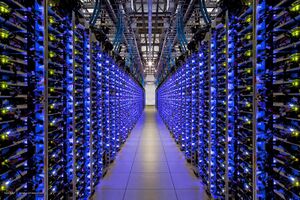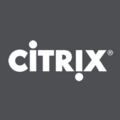Cloud computing is computing in which large groups of remote servers are networked to allow centralized data storage and online access to computer services or resources. Clouds can be classified as public, private or hybrid.
The cloud computing systems are those that contain category places (such as former school year or classmates), means to connect with friends (usually with self-description pages), and a recommendation system linked to trust. [1]
How Cloud Computing Works
The goal of cloud computing is to apply traditional supercomputing, or high-performance computing power, normally used by military and research facilities, to perform tens of trillions of computations per second, in consumer-oriented applications such as financial portfolios, to deliver personalized information, to provide data storage or to power large, immersive computer games. To do this, cloud computing uses networks of large groups of servers typically running low-cost consumer PC technology with specialized connections to spread data-processing chores across them. This shared IT infrastructure contains large pools of systems that are linked together. Often, virtualization techniques are used to maximize the power of cloud computing. [2]
Cloud Computing Standards
The standards for connecting the computer systems and the software needed to make cloud computing work are not fully defined at present time, leaving many companies to define their own cloud computing technologies. Cloud computing systems offered by companies, like IBM's "Blue Cloud" technologies for example, are based on open standards and open source software which link together computers that are used to to deliver Web 2.0 capabilities like mash-ups or mobile commerce. [3]
Cloud Computing in the Data Center and for Small Business
Cloud computing has started to obtain mass appeal in corporate data centers as it enables the data center to operate like the Internet through the process of enabling computing resources to be accessed and shared as virtual resources in a secure and scalable manner. For a small and medium size business (SMB), the benefits of cloud computing is currently driving adoption. In the SMB sector there is often a lack of time and financial resources to purchase, deploy and maintain an infrastructure (e.g. the software, server and storage). In cloud computing, small businesses can access these resources and expand or shrink services as business needs change. The common pay-as-you-go subscription model is designed to let SMBs easily add or remove services and you typically will only pay for what you do use.[4]
Major Cloud Computing Services and Providers Categories
Infrastructure-as-a-Service (IaaS)
IaaS cloud is probably the biggest one of them all. At its most basic, it's companies offering virtual space for a price in which customers can host and develop services.
Amazon Web Services AWS has cut prices ruthlessly in the face of competitors like Google and Microsoft. As a result, it's a key player in the IaaS market, where it hosts the back-ends of the likes of music streaming service Spotify. Now it's also jumped into the virtual desktop space with Amazon Workspaces, through which you can rent a virtual desktop running in AWS.
Microsoft Azure Redmond's IaaS cloud is a close rival to AWS, and boasts predictive analytics, private storage and disaster recovery services in its extensive wrapping. It has supported customers including Mazda and Lufthansa, and Marks & Spencers said a microsite it built in Azure took weeks instead of months.
Storage
Cloud storage can handle all kinds of structured and unstructured data - from documents to pictures, from multiple sources.
Google Drive Google's gone and upped its cloud storage offering by providing unlimited, free storage to all students. The "infinitely large" service complements Google Drive's regular 15GB free storage. It also combines the tools previously known as Google Docs, as well as all the files built with those tools, and offers the ability to create within Drive - an especially convenient feature when on the move. Its compatibility with iOS, Android, Windows and OS X means it's as useful on your desktop as on your smartphone.
Box The enterprise-focused cloud storage firm Box offers 10GB of space for free. To differentiate its offering in the face of stiff competition, Box has introduced Workflow, an engine that automates the routing of documents and files as well as the actions people need to take on them. That is an added bonus to its file-sharing service, which lets people work together on documents.
Dropbox Founded in 2007, Dropbox is a file hosting service that enables users to upload, view, edit and delete files hosted in Dropbox's servers. These files are accessible and may be synced across multiple computers (locally via Windows Explorer for Windows, Finder for Mac, etc.), mobile devices (locally via mobile apps) or browsers. Dropbox uses a freemium service model in which users who sign up get 2gb of free space automatically, with several pricing tiers to upgrade.
Desktop-as-a-Service (DaaS)
DaaS is a cloud service where the back-end of a virtual desktop is hosted by a cloud provider. A virtual desktop is a form of software that allows users to run multiple operating systems under the same set of hardware. Desktop virtualization allows for users to do more with fewer resources, especially when it comes to Daas.
Citrix The virtualization specialist is a big player in the DaaS space, aiming to go beyond a simple hosted workspace. It also provides hosted applications, secure mobile device management and secure file sync and share services.
VMware Whether it's spun off from EMC or not, VMware is the virtualization player. VMware Horizon provides remote desktop capabilities to allow users to run typically Microsoft operating systems like XP, Vista or Windows 7 within a virtual environment hosted on a server somewhere.
This is what's known as thin client computing, where the desktop's capabilities are virtualized, so the server in VMware's data centre provides the processing power for your computer, meaning all you really need is a monitor, keyboard and mouse.
Meanwhile, VMware Workstation is a hypervisor (a piece of software that creates and runs virtual machines) lets people set up multiple virtual machines on top of their physical desktop. That means you can run another operating system on your computer, or even run several. It can also simulate hard disk drives, and offers a web interface to connect users to local or server-hosted virtual machines via their desktop or mobile device.
Software-as-a-Service (SaaS)
SaaS is where software is hosted in the cloud, but appears on your device with full functionality.
Salesforce.com Salesforce has turned into the go-to provider for SaaS CRM solutions, with Gartner stating the firm is dominating the market. With the arrival of Force.com,
it's pushed into the world of Platform-as-a-Service (PaaS) to try and get other firms to build apps it can offer as part of its service, expanding its offering greatly.
Insightly One for the SMBs, Insightly provides CRM SaaS that integrate with Google's Gmail and Google Apps, as well as Outlook 2013 and Office 365. The idea is to help customers track their dealings with potential customers, with its SaaS apps accessible from both iOS and Android.
Platform-as-a-Service (PaaS)
PaaS is used by developers to build applications for web and mobile using tools provided by the PaaS provider - these range from programming languages to databases (eg SQL).
Red Hat OpenShift This open source-based PaaS provider lets developers customize it as much as they want, and can be provided free as a trial (just 1GB storage is offered, though). It comes in three variations: as a cloud-based service in 'Online', run from your data center in 'Enterprise' and as an open source app hosting platform in 'Origin'.
Heroku This platform supports a tonne of programming languages, from Java to Ruby to Python. One of the earliest PaaS providers, it offers third-party apps as well as its own 'dynos' - virtualised containers that run processes in siloed environments.
Google Translate
Google Translate has changed the way communicate and connect with people from all around the world. It is a convenient service offered by Google which gives users the option to translate a page into one of the many offered languages. This is a useful tool for those who have English as a second language or even for those who are trying to learn a new language. Google Translate can be used to translate a selection of a page or just the entire page. Google Translate also has a voice recording option, which the user can say a word or sentence to a microphone, and the page will translate it into the language that you want. [6]
References
<references> ]] [6]
- ↑ http://en.wikipedia.org/wiki/Cloud_computing
- ↑ http://www.webopedia.com/TERM/C/cloud_computing.html
- ↑ http://www.webopedia.com/TERM/C/cloud_computing.html
- ↑ http://www.webopedia.com/TERM/C/cloud_computing.html
- ↑ http://www.cbronline.com/news/cloud/cloud-saas/10-top-cloud-computing-providers-for-2014-4401618
- ↑ 6.0 6.1 http://googletranslate.blogspot.com/#googtrans/en/en










